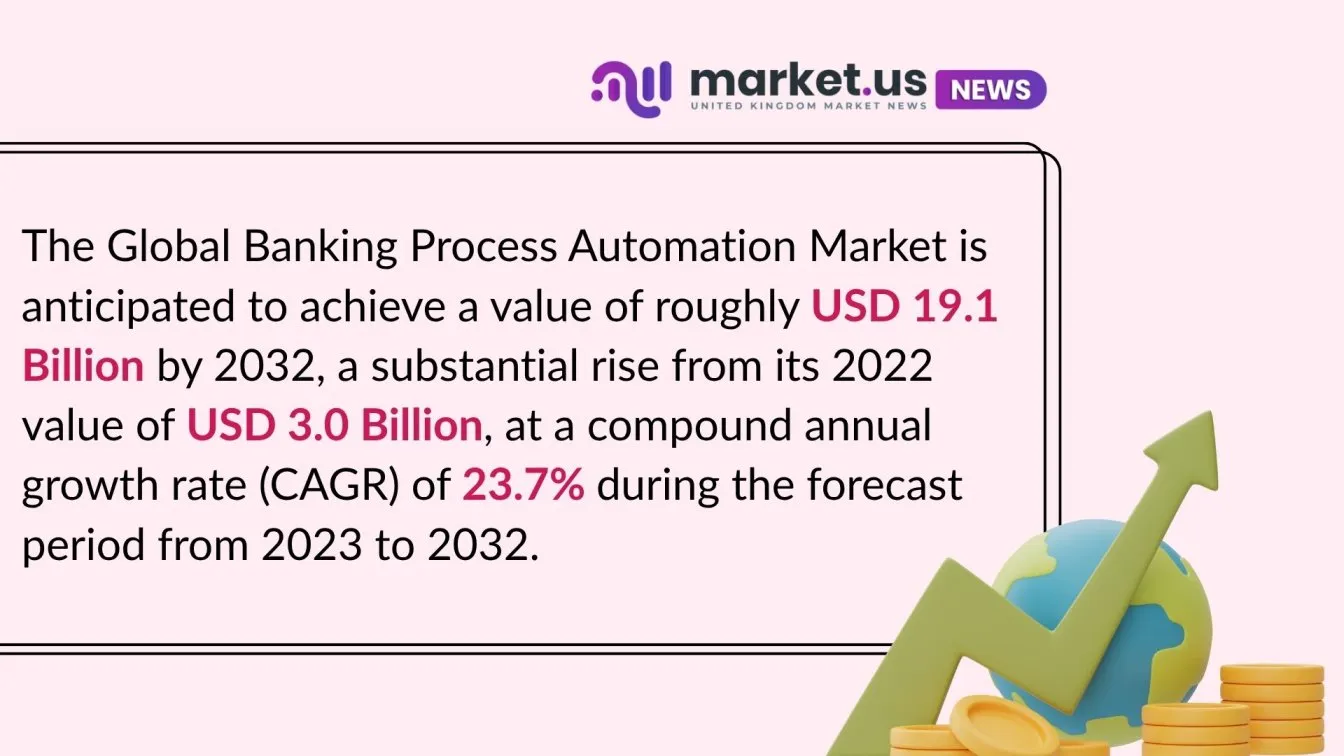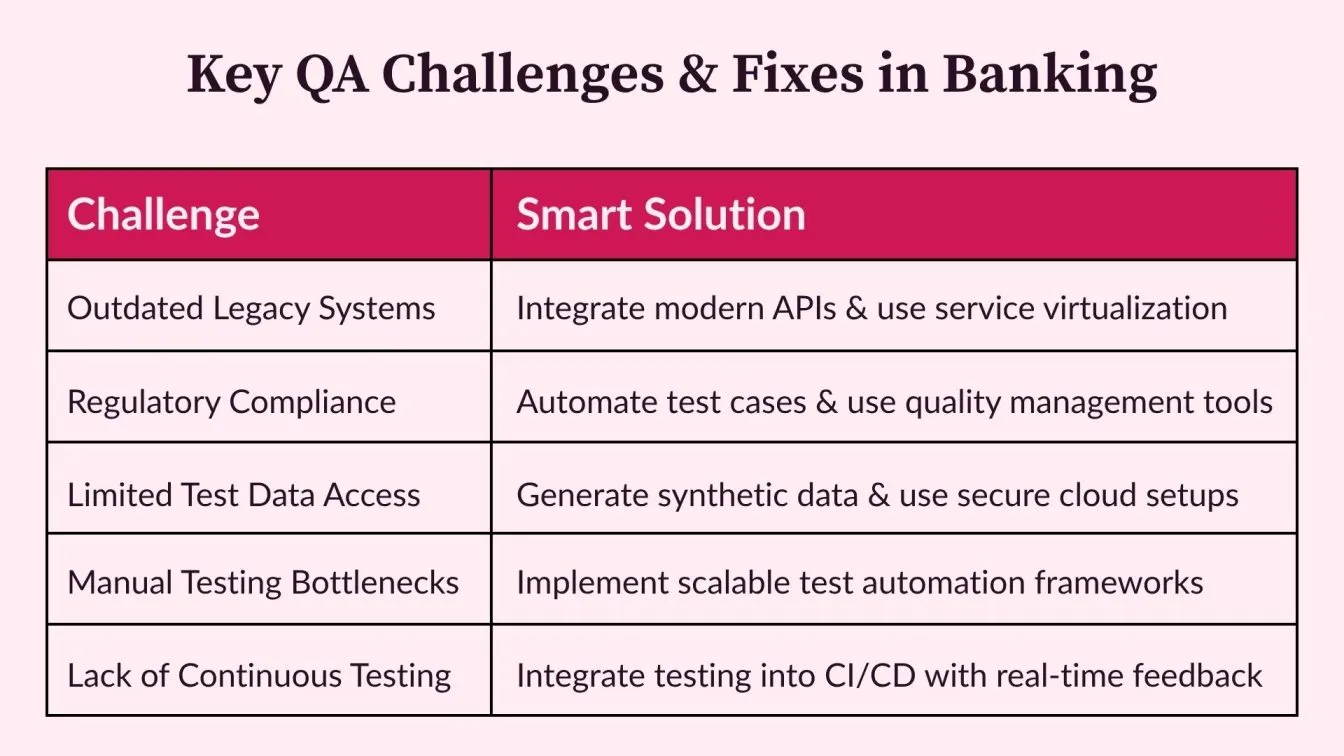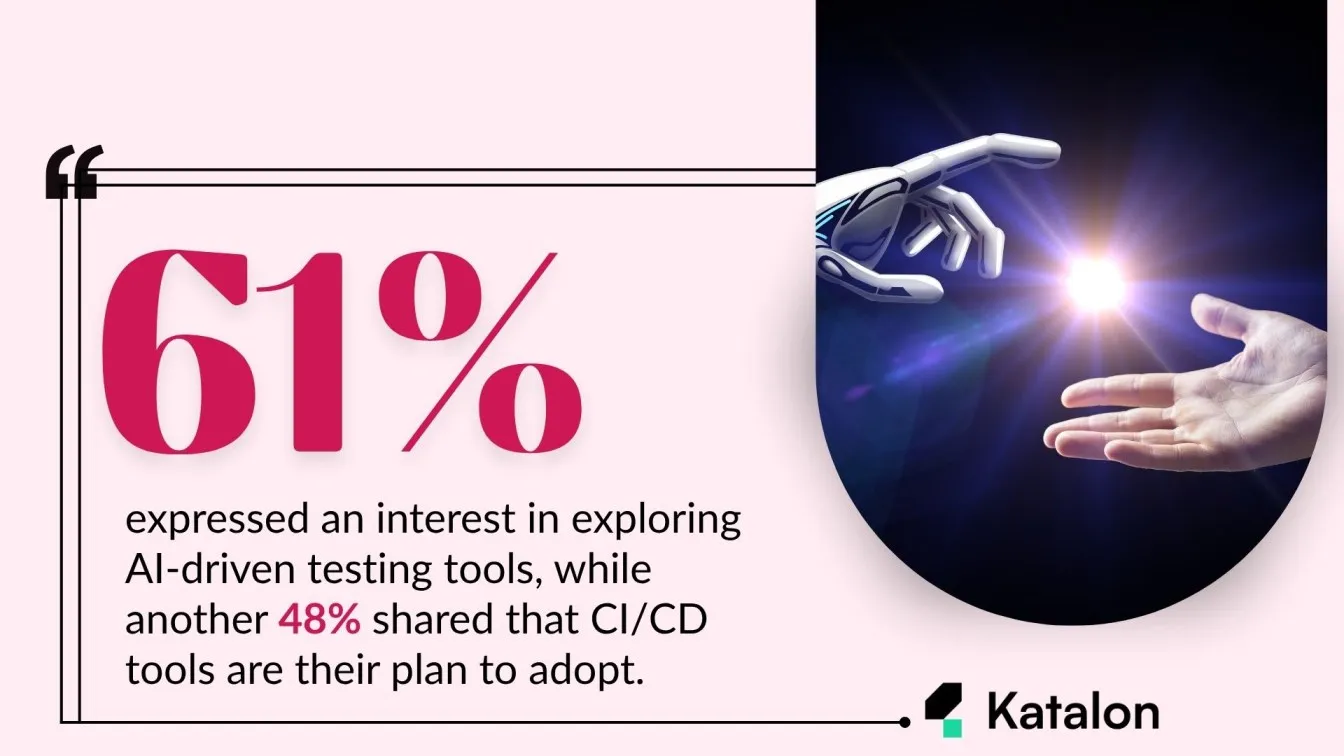Ensuring high software quality in banking is essential for delivering secure and reliable digital experiences. As banks modernize core banking software and adopt digital payments, the complexity of systems increases, making manual QA efforts inefficient.
By integrating automation testing, financial institutions can streamline processes, increase test coverage, and reduce human error. With the help of quality management software, code coverage tools, and automation testing services, banks can validate digital wallet payments, meet regulatory compliance, and accelerate product delivery. This guide explores how software testing automation is transforming quality assurance in banking software solutions for long-term success.
💡What’s Next? Keep reading to discover:
🚀 What does software quality and automation testing mean in banking
🚀 Common QA challenges like legacy systems and data issues
🚀 How automation boosts speed, accuracy, and compliance
🚀 Real-world QA use cases in payments and lending
🚀 Emerging trends like AI, ML, and cloud in test automation
Introduction to Software Quality and Automation Testing in Banking
In banking, software quality refers to the reliability, accuracy, and compliance of applications used for services like digital payments, loan processing, and core banking software operations. To ensure that these systems run efficiently without failures or delays, banks depend on tools like quality control software, quality assurance software, and quality management system software. These solutions help identify defects, monitor system performance, and maintain compliance with financial regulations.

As digital channels expand, the demand for faster, more accurate testing has led to widespread use of automation testing. By integrating automation testing tools and software automation testing frameworks, banks can execute thousands of test cases quickly and consistently. This enhances test coverage, reduces manual errors, and ensures the stability of banking software solutions, including digital wallet payments. Combined with data quality software and code coverage tools, this approach enables banks to deliver secure, high-performing applications while keeping pace with frequent updates and compliance needs.
Common QA Challenges in Banking
Quality assurance in banking comes with its own set of complexities. Financial applications must function reliably across legacy systems, third-party services, and modern digital platforms, all while complying with strict regulatory requirements. Manual QA efforts often struggle to keep up with the scale, speed, and security demands of banking systems. Below are some of the most common QA challenges faced by banks today.

Legacy Systems and Integration Issues
Many banks still operate on legacy infrastructure that predates modern digital technologies. These systems were not designed for real-time transactions, cross-platform integration, or scalable software updates. As banks move toward advanced banking software solutions and expand their mobile digital payments capabilities, quality assurance teams face serious integration hurdles that affect software performance and reliability.
- Inconsistent data flow: Legacy platforms often fail to synchronize with modern banking software, complicating the validation of real-time transactions.
- Lack of API compatibility: Older systems either lack APIs or use outdated protocols, making integration testing with automation testing tools difficult.
- Manual testing dependency: With limited test hooks or integration points, teams rely on manual efforts, reducing test coverage and increasing risk.
- Tool limitations: Many existing software automation testing frameworks are not compatible with legacy tech, limiting their application.
Regulatory and Compliance Requirements
Banking applications must strictly follow local and international laws governing data privacy, auditability, and financial transparency. These evolving data regulatory compliance requirements add significant pressure on QA teams to ensure each update meets both technical and legal standards. Failure to validate compliance thoroughly can lead to fines, customer data breaches, and reputational damage.
- Changing regulations: QA teams must frequently revise and extend test cases to stay aligned with current compliance and regulatory requirements.
- Extensive documentation needs: Meeting audit requirements demands well-documented results, which is difficult without quality management software.
- Third-party software validation: QA must ensure that integrated regulatory compliance software solutions function correctly with internal systems.
- High risk of failure: Without consistent validation using quality assurance software, even small non-compliant behaviors can result in penalties.
Limited Test Data and Environment Availability
Accurate testing in the banking sector requires environments that mirror production and datasets that reflect real-world user behavior. However, due to the sensitive nature of financial information, QA teams struggle to create safe and realistic test conditions. This impacts the effectiveness of both manual and automation testing efforts.
- Privacy constraints on real data: Data regulations prohibit the use of live customer information, creating the need for data quality software to generate secure alternatives.
- Slow environment setup: Preparing stable environments with full infrastructure and test coverage often delays project timelines.
- Low simulation accuracy: Without complete and high-quality test data, the QA team risks missing critical edge cases.
- Inconsistent results across environments: Without the support of reliable quality software, automation efforts may produce varying results due to environmental inconsistencies.
Difficulty in Scaling Manual Testing
With increasing product complexity and customer demand, banking systems require fast and repeated testing. Manual methods cannot match the speed and precision needed to maintain high software quality in fast-paced environments. This makes software testing and automation a necessity rather than an option.
- Time-consuming processes: Manual test cycles take longer, leading to release delays in digital banking software development.
- Limited functional coverage: Complex workflows across web, mobile, and third-party services cannot be fully covered manually.
- Error-prone execution: Repetitive test cases run by hand increase the chance of oversight, reducing quality control and test reliability.
- Resource dependency: Scaling manual efforts requires additional staff, while automation testing services scale without increasing headcount.
Lack of Continuous Testing in Agile Environments
Agile and DevOps are now common in the banking landscape, but many banks still struggle to align testing with development. This affects the customer experience and weakens software quality assurance for key systems like the core banking system and enterprise architecture.
- Delayed feedback loops: Without automation, test insights reach teams late, raising defect costs.
- Weak CI/CD integration: Testing isn’t embedded in delivery pipelines, limiting automation value.
- Coverage gaps: Speedy releases often skip critical flows, including usability testing and code-level checks.
- Release slowdowns: Without embedded automation testing tools, QA becomes a bottleneck in deployment workflows.
How Automation Testing Enhances Software Quality in Banking
Automation testing plays a vital role in improving software quality, reducing risks, and speeding up release cycles in banking software. With growing complexity in digital payments, banks rely on test automation tools to meet compliance, security, and performance goals.

- Greater Test Coverage in Less Time
Automation enables broader test coverage across platforms. Banks validate services like digital wallet payments and payment processing systems using web application testing and cross-platform testing for faster, more reliable results. - Early Detection of Defects
Through regression testing and API testing, automation identifies bugs early in the pipeline. This improves software quality assurance, reduces rework, and enhances the customer experience. - Consistent Compliance Checks
Automated tests using regulatory compliance software solutions ensure each release meets KYC, data, and security standards keeping banks aligned with the changing regulatory landscape. - Secure and Realistic Test Data
With data quality software, QA teams generate masked or synthetic data to safely test financial transactions, protecting sensitive data and supporting effective security testing. - Accurate and Repeatable Results
Automation eliminates manual errors and ensures consistent validation of complex calculations like EMIs, reinforcing trust in quality assurance software and stable banking operations. - Insights through Code Coverage Tools
Code coverage tools help teams monitor tested areas, improve testing methodologies, and enhance quality in core banking systems by targeting untested code paths.
Real-World Use Cases of QA and Automation in Banking
Banks are applying software testing automation to improve digital experiences, ensure data accuracy, and meet compliance needs. Here are three real-world-inspired examples where testing plays a critical role.
1. Testing Digital Payment Flows to Prevent Failures
With the growing usage of payment processing systems and virtual services, banks must guarantee uninterrupted, secure, and fast transactions. Automated regression testing, API testing, and performance testing ensure flawless payment flows across platforms.
Example:
A private bank in Mumbai used test scripts to stress-test its UPI infrastructure, uncovering double deductions caused by retry failures. This issue was resolved pre-deployment, improving customer service, protecting sensitive data, and reinforcing trust in its security measures. The team also used Cross-Platform Testing to ensure consistent performance across devices and browsers, boosting the success rate of financial transactions.
2. Automating Compliance Checks in Banking Applications
Every release of core banking software must adhere to laws like KYC and AML. Manual validation slows delivery, but AI-augmented testing strategies and security testing now enable faster, more reliable compliance verification.
Example:
A public bank integrated regulatory compliance software solutions into its automated pipeline. Tests flagged incomplete KYC forms and delayed suspicious transaction alerts. This prevented compliance penalties, supported cloud computing deployment needs, and ensured strong security features for better risk control.
3. Validating Loan Data and Calculations Accurately
Loan and credit systems require accurate complex calculations for EMI and interest rates. Using data quality software and web application testing, banks validate every input condition and ensure error-free automation across lending platforms.
Example:
Automated test runs at a regional bank uncovered EMI miscalculations in rate-change scenarios. Fixes ensured smooth rollouts and aligned with customer expectations for clear, personalized offerings. Usability testing and compatibility testing helped ensure the loan portal worked across browsers and devices delivering accessible, user-friendly personalized services.
Future Trends in Banking Test Automation
Banks are adopting AI, ML, and cloud technologies to make software testing more predictive, scalable, and efficient across digital platforms, digital payments, and banking software, improving quality, reducing risk, and accelerating delivery.
- AI and ML-Driven Test Intelligence
Artificial Intelligence and Machine Learning are transforming automation testing. They enable smart test case generation, defect prediction, and script maintenance. This boosts software quality and testing accuracy across banking software services. - Continuous and Shift-Left Testing
QA is moving earlier in the development lifecycle. Integrated into CI/CD, software testing automation improves code coverage, speeds up releases, and reduces production issues in digital banking software.

- Automated Compliance Validation
Banks are using AI-enabled regulatory compliance software solutions to automate audit checks, data privacy validation, and fraud monitoring ensuring faster, more consistent compliance testing. - Cloud-Based Testing Infrastructure
Cloud platforms allow flexible, on-demand environments that support large-scale automated testing. This improves test coverage for services like digital wallet payments and mobile banking applications. - Predictive Analytics for Quality Improvements
By analyzing past defects and test patterns, banks use ML and quality management software to prioritize risk areas, improve test planning, and deliver higher quality software.
Conclusion: Strengthening Digital Banking with QA Automation
As banking systems evolve, ensuring consistent software quality is crucial for operational efficiency and customer trust. Automation testing improves test coverage, speeds up releases, and reduces errors across digital payments, core banking software, and compliance workflows. By integrating the right automation testing tools, quality assurance software, and quality management system software, banks can maintain accuracy, meet regulatory compliance requirements, and deliver reliable services across all digital platforms.

Frugal Testing, a leading SaaS application testing company, is renowned for its specialized AI-driven test automation services tailored to meet the evolving needs of modern businesses. Among the comprehensive services offered by Frugal Testing are advanced Fintech Software Testing Services, designed to ensure security, performance, and compliance in financial applications. The company also provides cloud-based test automation services, enabling scalable, efficient, and cost-effective testing solutions.
People Also Ask
👉 What is a QMS system in banking?
A Quality Management System (QMS) is a structured framework for managing and improving software quality in banking. It includes processes and quality control software to ensure compliance and service consistency.
👉 What role does API testing play in modern banking systems?
API testing verifies communication between internal systems and third-party services. It ensures seamless transactions, accurate data, and early bug detection.
👉 How is test data secured in banking QA?
Banks use data quality software and masking to create secure, synthetic test data. This protects sensitive data while maintaining realistic testing.
👉 What challenges occur when testing third-party banking integrations?
Issues include unstable APIs, limited environment access, and data mismatches. These affect usability testing, delay fixes, and reduce test coverage.
👉 How do banks validate automation test results?
Banks validate test results using logs, comparisons, and code coverage tools. This ensures accuracy and confidence in testing automation.





%201.webp)

